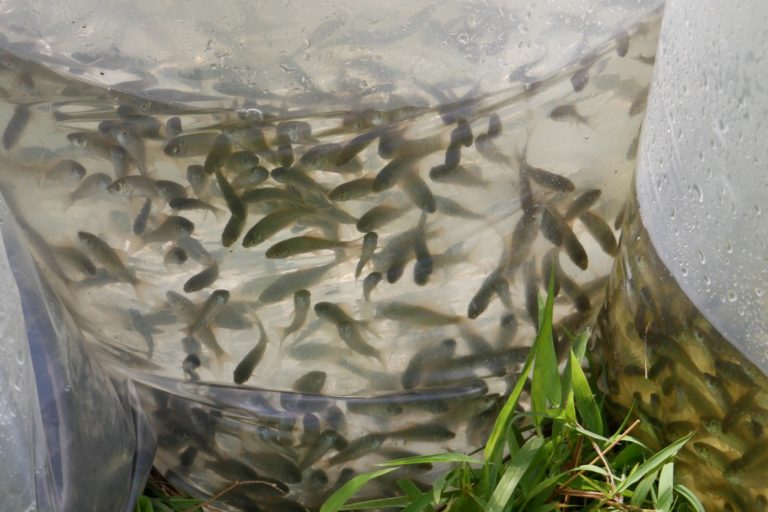In 2015, smelly mats of a brown macroalgae called sargassum piled as high as 1.2 meter (4 feet) on the beaches of Barbados, recalls Joshua Forte. It was the fourth…
A machine learning model of ammonia emissions from the world’s rice, wheat and corn crops shows that optimal fertilizer management could slash ammonia air pollution from these crops by 38%.
Nitrogen pollution from agriculture and human waste, along with other pollutants including plastics, could make clean water scarce in many watersheds worldwide, potentially contributing to declines in public health.
As the world grapples with escalating climate change, policymakers remain laser-focused on CO2, with humanity striving to decarbonize energy systems, capture carbon, issue carbon credits, and plant millions of trees…
This story has been supported by the Fund for Investigative Journalism. Carrying a shovel on her shoulder, Nely Flores walks quickly on the beach. “Before the guards from the mine…
As oil and gas production surge, shifting the global economy to a circular model is essential to charting a path away from fossil fuels, petroleum-based nitrogen fertilizers and petrochemicals such as plastics. Part 3 of a three-part miniseries.
This story is the second in a three-part mini-series surveying the range of impacts by the fossil fuel industry on the global environment. Part one and part two review harm…
Fossil fuels have done great good for humanity, but they are now not only threatening our planet’s climate, but also taking a terrible toll on the global environment, putting at risk Earth systems vital to life as we know it. Part 1 of a three-part miniseries.
In the two decades since the Franco-British multinational Perenco established operations at Muanda, at the mouth of the Congo River, surrounding communities have suffered the loss of the natural resources…
KOLAKA, Indonesia — Ansal grabbed a makeshift raincoat, an empty rice sack, and ran home as the rain began to pound the fields of Pomalaa. A few hours later, after…
JAMBI — A quintet of Jambi residents gathered one morning in May at the home of Leni Haini, an Indonesian environmental activist who last year received a prestigious award from…
With 2023 expected to see record amounts of brown macroalgae washing up on Caribbean beaches, green entrepreneurs in Mexico are turning waste into biogas, biofertilizer and even faux leather; all despite big bureaucratic hurdles.
Last year, a car fueled by human waste toured the European countryside, covering more than 2,000 kilometers (1,200 miles). It was the culmination of To-Syn-Fuel, a pathfinding project using technology…
LAGOS — Across Atorin-Ijesha in southwestern Nigeria, the clatter of stones fills the air as excavators aggressively dig into the soil. Gold miners work from dawn till dusk excavating the…
Pollution from a variety of sources is driving up the incidence of resistance to the compounds used to treat infections, according to a report released by the United Nations Environment…
Zambians launch lead poisoning lawsuit against mining giant Anglo American A group of 140,000 women and children from Zambia’s Kabwe district is seeking to bring a class action lawsuit against…
In an effort to feed 170 million people in a rapidly growing economy, Bangladeshi farmers rely on the widespread use of chemical fertilizers to boost production, leaving the country’s soil…
The tobacco supply chain has harmful consequences for forests, oceans and the climate, and also for farmers and their families who produce the crop — all to an extent that is not yet fully known.
KATHMANDU– When German professor Jochen Martens and his associate W. Schawaller visited subtropical forests in Nepal in 1988, they collected samples of different insects found in eastern Nepal, including a “bizarre”…
BANDUNG, Indonesia — In a valley downstream from the source of the Citarum River, retired army general Doni Monardo approaches a magnolia tree planted in 2018 by President Joko Widodo…
BANYUMAS/JAKARTA, Indonesia — A muddy flood polluting a river on the Indonesian island of Java earlier this year depleted its fish stock, raising calls for restoration and restocking efforts in…
Ban Khao Mo, THAILAND — Standing in the house where she has lived since she was born 45 years ago, Premsinee Suntornthammathat points to the temple where her grandparents took…
The summit of Cadillac Mountain in Acadia National Park in the northeastern U.S. state of Maine offers sweeping, unobstructed views of Frenchman Bay. Surrounded by islands and rocky shorelines, the…
The central coast of Peru is cleaning up after a catastrophe due to a large oil spill on Jan. 15, 2022. The environmental emergency occurred after a pipe ruptured between…
7.8 billion people produce a lot of waste, but governments, entrepreneurs and NGOs are developing a host of technologies that work with nature to transform a dirty problem into a suite of elegant sustainable solutions.
It doesn’t get talked about much, but 7.8 billion humans make a lot of waste, and a lot of it is flowing into the planet’s rivers, estuaries and oceans, with major impacts on clean water, biodiversity and public health.
Scientists analyzed levels of chemical pollutants in native jataí bees across eight landscapes in Brazil’s São Paulo state. They found that in landscapes with more vegetation, the bees had fewer pollutants, at lower levels, indicating that the plants act as a filter and protective barrier
Industrial agriculture feeds billions of people and created the modern world. But the nitrogen and phosphorus it’s fertilized with is putting the biosphere, and humanity, at risk.
On Feb. 8, 2019, two weeks after the collapse of a dam holding mining waste killed 272 people and left a trail of destruction in Brumadinho, in the Brazilian state…
MIAMI — Along the Miami shoreline, luxury high-rises and condominiums run parallel to Biscayne Bay, one of South Florida’s most biodiverse ecosystems, characterized by its once abundant coral reefs, seagrass…





































